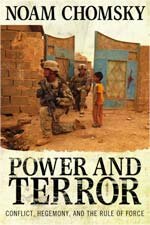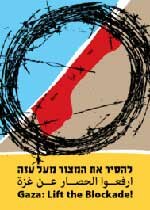By Amira Hass, Haaretz – 14 Aug 2009
www.haaretz.com/hasen/spages/1107447.html

Samir al-Attar at home
Forty Palestinians from the Gaza Strip were incarcerated in Israel Prison Service facilities during Operation Cast Lead at the beginning of this year, and 21 are still in prison. That’s a very small number, compared to the many hundreds the Israel Defense Forces arrested in Gaza, and as compared with the hundreds who were transferred for interrogation to various detention facilities in Israel before being released.
Samir al-Attar, 38, is one of the 40; his eldest son Hussein, 13, spent three days together in a makeshift prison. The father was then placed on a truck and the son was released. “Is the boy still traumatized by the arrest?” the father was asked this week by telephone. “Not all that much,” he replied. “What Hussein saw when he was let out made him forget the ordeal of the arrest.”
Separated from his father, the boy started to walk home. Their neighborhood was empty, many of the houses had been destroyed or were riddled with bullet holes, and the fields, groves and hothouses were leveled. The sound of shelling accompanied Hussein all the time; an Israeli sniper could be lurking behind every window.
“The boy reached our house. All the windows were smashed. He did not find anyone and thought they had all been killed – his mother, his grandmother and his five brothers and sisters,” Samir related.
Frightened and virtually alone in a ghost town, the boy wandered about aimlessly. It was not until the following day that he ran into a relative, who led him four kilometers by foot to a school where his family had taken shelter. “That fear,” his father says, “is still eating him.”
The mass arrests did not become a major topic of conversation in the Gaza Strip: Uncertainty about the fate of loved ones and shock at the scale of the killing and destruction overshadowed the experience of being detained.
Samir himself was released only two and a half months after being arrested. A farmer, who before being arrested supplemented his income by serving as a driver for Kamal Shrafi, Palestinian President Mahmoud Abbas’ adviser on human rights (and a former member of the Palestinian Legislative Council).
On Monday, January 5, IDF soldiers had already begun to shoot directly at Samir al-Attar’s home and not just around it. He and his family fled. His wife waved a white cloth; he held their sons of 5 and 7 in his arms. He spotted 50 soldiers in front of the house. The soldiers ordered them to put their hands up. The soldiers fired between their legs, al-Attar said on the phone this week, then one searched him. One hand was handcuffed to Hussein’s hand, and the two were then blindfolded and taken to a neighboring house, along with another 10 detainees.
“The soldiers treated us well in the house, but did not give us food or water, and let us use the toilet only once,” Samir stated in an affidavit he submitted on January 14 in Ketziot, to attorney Maher Talhami from the Public Committee against Torture in Israel (PCAT).
At 5 P.M. the two were taken, again on foot, in a convoy, still blindfolded and handcuffed to each other, to an area in which the IDF had massed tanks and bulldozers. This is called a “defensive zone” in army lingo – a jora (hole) by residents, and a “dugout” by the PCAT. It was a man-made crater of about two dunams (half an acre), two to three meters deep and surrounded by mounds of the sand that had been removed to create it, which rose up to three meters high – “higher than the bulldozers,” al-Attar said on Wednesday. Previously the site had been a vegetable patch.
It was beginning to get dark, but there was a little light from the tank headlights. “The tanks were then firing shells at Beit Lahiya,” al-Attar stated in the affidavit. At the soldiers’ order, the prisoners descended carefully, holding on to one another, their eyes still covered. In the crater, the soldiers handcuffed his son separately. There were already detainees there, and more arrived during the next two days. When his group arrived, the soldiers enclosed them with concertina wire.
“Not until Tuesday morning did they give every two people a single blanket, against the bitter cold,” al-Attar told Talhami. “We were handcuffed during the whole period and sat on the sand.” (Their eyes were covered, too, he would say on the phone – a detail he had forgotten to add in the affidavit. Occasionally they shifted the strip of flannel a little so they could see.) “The soldiers gave us food (pita and mortadella sausage) once or twice a day. We would ask for water and sometimes they would bring it long after.” (“Another five minutes, they would say, and bring it two or three hours later,” he explained on the phone.) “There was no toilet there and we were not given sanitary products such as toilet paper.”
When someone could no longer hold himself in, he moved away and relieved himself. People who wanted to pray also moved to the side but, al-Attar said on the phone, no one dared to kneel in front of the soldiers, because “the fear was great.” The soldiers – on the other side of the concertina wire, where there were also dogs – shouted at the detainees to shut them up when they heard them talking.
Al-Attar: “The tanks were 10 meters from us and they shelled and fired day and night. Even if we had wanted to, we could not sleep because of the noise, the cold and the fear. I hugged Hussein and told him not to be afraid, that it would all be over in a day or two, that we would not die. But inside I was terribly worried. There were four women and 10 children under the age of 14 with us. They were also handcuffed and blindfolded.”
‘Clear procedures’
About 30 detainees who arrived in a different group on that same Monday afternoon were placed on trucks, H.A., 26, stated in an affidavit to Talhami. “It was very cold and we were forced to sleep in the truck. I was handcuffed and blindfolded … The soldiers handed out a few blankets to the people, but not enough. Maybe one for every two people. We were kept in the truck until the next afternoon [Tuesday]. Anyone who had to relieve himself did it over the side of the truck. The soldiers ordered us not to talk; anyone who did was hit.”
H.E., 23, was arrested in a group whose members were handcuffed at their backs. In an affidavit submitted to attorney Majd Bader, also from PCAT, he stated: “We went for a time on foot from one place to another, which I did not know … While walking I was hit by soldiers. I heard them say ‘son of a bitch,’ ‘asshole’ and other curses. Afterward, we discovered that we were in a pit with other people … We were kept in that pit for three days, without food, water or access to a toilet, even though we asked to do it, but the soldiers refused … While we were there, the Israeli tanks scattered near the pit kept up the shelling. We were handcuffed and our eyes were covered, next to one another … ”
F.R., who also spent one night on the truck, noticed that the women were held in a separate pen created by coils of barbed wire. “The soldiers only supplied mattresses and blankets to the women and the children,” he said.
The interrogations were conducted in other detention facilities, outside Gaza, under equally severe conditions. On January 8, even before they were in possession of all the details about the incarceration, representatives of human rights organizations in Israel wrote to the military advocate general, Avichai Mandelblit, to remind him that it was the IDF’s obligation to uphold the detainees’ rights. In a reply dated January 19, Brigadier General Mandelblit wrote: “These arrests were made in accordance with clear procedures, which guide our forces to, among other instructions, preserve the honor and health of the detainees and to hold them in proper conditions. These procedures were worked out in a manner consistent with Israel’s obligations regarding the laws of warfare.”
The IDF spokesman’s response: “The officers and soldiers who were involved in the detentions and dealt with the detainees underwent briefings and training. The ‘dug-outs’ described in the article were protected areas created with the objective of protecting soldiers and armored equipment from attacks by light weapons, anti-missile fire and incursions by terrorists. In the area in question, soldiers and detainees shared the same conditions, in accordance with the strictest regulations concerning consumption of food and drink, and maintenance of basic living conditions during combat. Specific charges concerning incidents of abuse have been passed on for investigation as per the usual army protocol.”
The IDF did not respond to the question of how many Palestinians were arrested in Gaza and how many were transferred to Israel.






































